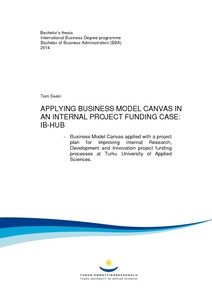Project management for scientific research
Dutta, Arpan (2024)
Dutta, Arpan
2024
All rights reserved. This publication is copyrighted. You may download, display and print it for Your own personal use. Commercial use is prohibited.
Julkaisun pysyvä osoite on
https://urn.fi/URN:NBN:fi:amk-202405049179
https://urn.fi/URN:NBN:fi:amk-202405049179
Tiivistelmä
Contemporary scientific research is often realized through research, development, and innovation projects and is usually driven by project funding from academic and industrial ties. Consequently, a need arises to deploy project management for managing scientific research. In this context, this thesis aims to construct an optimal project management framework for scientific research and develop guiding project management models for scientific research projects. To attain these objectives, quantitative and qualitative research are performed, and a small university research unit is chosen for the study.
To construct an optimal project management framework, the research life cycle of a scientific research project and the project life cycle of a generic project are compared to choose suitable frameworks for each life cycle phase from the existing literature through a systematic literature review. Once the framework is constructed, its relevance in scientific research is justified in terms of the collective opinion of the research unit under study. To deduce this collective opinion, quantitative research is performed by conducting an online survey and statistically analyzing the survey responses. The quantitative study revealed that the chosen research unit collectively prefers project ideation using blue ocean and lean strategies, project management using hybrid (waterfall and agile) methods, and transformational project leadership.
Based on the findings mentioned above, project management models are developed for scientific research projects through qualitative research. By conducting action research within the chosen research unit and employing qualitative content analysis on the action responses, guiding models are developed for project strategy (blue ocean and lean), project leadership (transformational 6-L), and project management (lean-hybrid). The qualitative study revealed that the project strategy model ensures value innovation, cost minimization, and flow of created values. The project leadership model promotes emotional intelligence, commitment to people, and a growth mindset. The project management model secures values, minimizes waste, and mitigates the volatility of scientific research. To afford adaptability, the high-level project tasks that require more planning are performed using the waterfall method, while the low-level project tasks that require more agility are conducted in an agile way. Collectively, the guiding models provide key information on how to implement project management in scientific research.
To construct an optimal project management framework, the research life cycle of a scientific research project and the project life cycle of a generic project are compared to choose suitable frameworks for each life cycle phase from the existing literature through a systematic literature review. Once the framework is constructed, its relevance in scientific research is justified in terms of the collective opinion of the research unit under study. To deduce this collective opinion, quantitative research is performed by conducting an online survey and statistically analyzing the survey responses. The quantitative study revealed that the chosen research unit collectively prefers project ideation using blue ocean and lean strategies, project management using hybrid (waterfall and agile) methods, and transformational project leadership.
Based on the findings mentioned above, project management models are developed for scientific research projects through qualitative research. By conducting action research within the chosen research unit and employing qualitative content analysis on the action responses, guiding models are developed for project strategy (blue ocean and lean), project leadership (transformational 6-L), and project management (lean-hybrid). The qualitative study revealed that the project strategy model ensures value innovation, cost minimization, and flow of created values. The project leadership model promotes emotional intelligence, commitment to people, and a growth mindset. The project management model secures values, minimizes waste, and mitigates the volatility of scientific research. To afford adaptability, the high-level project tasks that require more planning are performed using the waterfall method, while the low-level project tasks that require more agility are conducted in an agile way. Collectively, the guiding models provide key information on how to implement project management in scientific research.
Kokoelmat
Samankaltainen aineisto
Näytetään aineisto, joilla on samankaltaisia nimekkeitä, tekijöitä tai asiasanoja.
-
Project management in practice : Evaluating a case project through project management theories
Uusitalo, Jenni (Metropolia Ammattikorkeakoulu, 2013)The purpose of this thesis was to evaluate a case project and to study whether it was carried out in a correct manner; meaning that did the case project follow the project management models. In addition, part of the study ... -
I want to be a good project manager : Requirements to be a project manager in the context of multinational IT projects
Dmitrieva, Darja (Tampereen ammattikorkeakoulu, 2012)The main purpose of this thesis is to describe management methods and tools for multinational IT projects. All conclusions are based on the research, when few cases were studied and analyzed. Those cases are IT projects, ... -
Applying Business Model Canvas in an internal project funding case: IB-HUB : Business Model Canvas applied with a project plan for improving internal Research, Development and Innovation project funding processes at Turku University of Applied Sciences
Sivén, Tom (Turun ammattikorkeakoulu, 2014)During the past few years, internal projects were launched at Turku University of Applied Sciences at a growing rate. One of these internal projects has been IB-HUB, which brought the idea of improving the internal Research, ...



